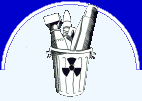


 |
 |  | ||||
|
|
|
|
| |||
| vous etes ici Homepage > News > External sources > "Doomsday Clock" Moves Two Minutes Closer To Midnight | |
|
It is 5 minutes to Midnight "Doomsday Clock" Moves Two Minutes Closer To Midnight Physicians launch International Campaign to Abolish Nuclear weapons Published 17 January 2007 Bulletin of the Atomic Scientists Adjusts Clock From 7 to 5 Minutes Before Midnight; “ Deteriorating” Global Situation Cited on Nuclear Weapons and New Factor: Climate Change. ANNOUNCEMENTS 17 January 2007 | 10:14 PM WASHINGTON, D.C. and LONDON, ENGLAND /// January 17, 2007 /// The Bulletin of the Atomic Scientists (BAS) is moving the minute hand of the Doomsday Clock two minutes closer to midnight. It is now 5 minutes to midnight. Reflecting global failures to solve the problems posed by nuclear weapons and the climate crisis, the decision by the BAS Board of Directors was made in consultation with the Bulletin’s Board of Sponsors, which includes 18 Nobel Laureates. BAS announced the Clock change today at an unprecedented joint news conference held at the American Association for the Advancement of Science in Washington, DC, and the Royal Society in London. In a statement supporting the decision to move the hand of the Doomsday Clock, the BAS Board focused on two major sources of catastrophe: the perils of 27,000 nuclear weapons, 2000 of them ready to launch within minutes; and the destruction of human habitats from climate change. In articles by 14 leading scientists and security experts writing in the January-February issue of theBulletin of the Atomic Scientists (http://www.thebulletin.org), the potential for catastrophic damage from human-made technologies is explored further. Created in 1947 by the Bulletin of the Atomic Scientists, the Doomsday Clock has been adjusted only 17 times prior to today, most recently in February 2002 after the events of 9/11. By moving the hand of the Clock closer to midnight - the figurative end of civilization - the BAS Board of Directors is drawing attention to the increasing dangers from the spread of nuclear weapons in a world of violent conflict, and to the catastrophic harm from climate change that is unfolding. The BAS statement explains: "We stand at the brink of a Second Nuclear Age. Not since the first atomic bombs were dropped on Hiroshima and Nagasaki has the world faced such perilous choices. North Korea’s recent test of a nuclear weapon, Iran’s nuclear ambitions, a renewed emphasis on the military utility of nuclear weapons, the failure to adequately secure nuclear materials, and the continued presence of some 26,000 nuclear weapons in the United States and Russia are symptomatic of a failure to solve the problems posed by the most destructive technology on Earth." The BAS statement continues: "The dangers posed by climate change are nearly as dire as those posed by nuclear weapons. The effects may be less dramatic in the short term than the destruction that could be wrought by nuclear explosions, but over the next three to four decades climate change could cause irremediable harm to the habitats upon which human societies depend for survival." Stephen Hawking, a BAS sponsor, professor of mathematics at the University of Cambridge, and a fellow of The Royal Society, said: "As scientists, we understand the dangers of nuclear weapons and their devastating effects, and we are learning how human activities and technologies are affecting climate systems in ways that may forever change life on Earth. As citizens of the world, we have a duty to alert the public to the unnecessary risks that we live with every day, and to the perils we foresee if governments and societies do not take action now to render nuclear weapons obsolete and to prevent further climate change." Kennette Benedict, executive director, Bulletin of the Atomic Scientists, said: "As we stand at the brink of a Second Nuclear Age and at the onset of unprecedented climate change, our way of thinking about the uses and control of technologies must change to prevent unspeakable destruction and future human suffering." Sir Martin Rees, president of The Royal Society, professor of cosmology and astrophysics , master of Trinity College at the University of Cambridge, and a BAS sponsor, said: "Nuclear weapons still pose the most catastrophic and immediate threat to humanity, but climate change and emerging technologies in the life sciences also have the potential to end civilization as we know it." Lawrence M. Krauss, professor of physics and astronomy at Case Western Reserve University, an a BAS sponsor, said: "In these dangerous times, scientists have a responsibility to speak truth to power especially if it might provoke actions to reduce threats from the preventable technological dangers currently facing humanity. To do anything else would be negligent." Ambassador Thomas Pickering, a BAS director and co-chair of the International Crisis Group, said: "Although our current situation is dire, we have the means today to successfully address these global problems. For example, through vigorous diplomacy and international agencies like the International Atomic Energy Agency, we can negotiate and implement agreements that could protect us all from the most destructive technology on Earth-nuclear weapons." Highlights of the new statement from the Bulletin of Atomic Scientists include the following: "The second nuclear era, unlike the dawn of the first nuclear age in 1945, is characterized by a world of porous national borders, rapid communications that facilitate the spread of technical knowledge, and expanded commerce in potentially dangerous dual-use technologies and materials. The Pakistan-based network that provided nuclear technologies to Libya, North Korea, and Iran, is an example of the new challenges confronting the international community." "Sixteen years after the end of the Cold War, following substantial reductions in nuclear weapons by the United States and Russia, the two major powers have now stalled in their progress toward deeper reductions in their arsenals." "More than 1400 metric tons of highly enriched uranium and approximately 500 tons of plutonium are distributed worldwide at some 140 sites, in unguarded civilian power plants and university research reactors, as well as in military facilities." "Global warming poses a dire threat to human civilization that is second only to nuclear weapons. Through flooding and desertification, climate change threatens the habitats and agricultural resources that societies depend upon for survival. As such, climate change is also likely to contribute to mass migrations and even to wars over arable land, water, and other natural resources." "The prospect of civilian nuclear power development in countries around the world raises further concerns about the availability of nuclear materials. Growth in nuclear power is anticipated to be especially high in Asia, where Japan is planning to bring on line five new plants by 2010, and China intends to build 30 nuclear reactors by 2020." "Several factors are driving the turn to nuclear power- aging nuclear reactors, rising energy demands, a desire to diversify energy portfolios and reduce reliance on fossil fuels, and the need to reduce carbon emissions that cause climate change. Yet expansion of nuclear power increases the risks of nuclear proliferation." Reduce the launch readiness of U.S. and Russian nuclear forces and completely remove nuclear weapons from the day-to-day operations of their militaries. ABOUT BAS AND THE CLOCK The Bulletin of the Atomic Scientists was founded in 1945 by University of Chicago scientists who had worked on the Manhattan Project and were deeply concerned about the use of nuclear weapons and nuclear war. In 1947 the Bulletin introduced its clock to convey the perils posed by nuclear weapons through a simple design. The Doomsday Clock evoked both the imagery of apocalypse (midnight) and the contemporary idiom of nuclear explosion (countdown to zero). In 1949 Bulletin leaders realized that movement of the minute hand would signal the organization’s assessment of world events. The decision to move the minute hand is made by the Bulletin’s Board of Directors in consultation with its Board of Sponsors, which includes 18 Nobel Laureates. The Bulletin’s Doomsday Clock has become a universally recognized indicator of the world’s vulnerability to nuclear weapons and other threats. Additional information is available on the Web at http://www.thebulletin.org. CONTACT: Patrick Mitchell, (703) 276-3266 or pmitchell@hastingsgroup.com. EDITORS NOTE: A streaming audio replay of the news event will be available on the Web at as of 6 p.m. ET and 11 p.m. in London/2300 GMT on January 17, 2007. Physicians launch campaign as hands of Doomsday Clock move closer to midnight MEDIA Release- Due to new and increasing nuclear dangers, on Wednesday 17 January 2007 the hands of the Doomsday clock will be moved closer to midnight The Doomsday Clock shows the time between the beginning of human evolution and nuclear destruction. It was created by artist Martyl Langsdorf and the board of directors of the Bulletin of the Atomic Scientists, based at Chicago University. According to the board of directors, the risk of nuclear warfare has changed over time; the minute hand of the clock has therefore moved back and forth 17 times, currently resting at 7 minutes to midnight, the same time it displayed when the clock made its debut in 1947. The hands of the Doomsday Clock are changing for many reasons, including the upgrading, modernizing and testing of new nuclear weapons by Nuclear Weapon States. Australia supplying uranium to China, freeing up its uranium for its weapons programme, is hindering rather than helping this situation. North Korea becoming the 9th state to possess nuclear weapons is a terrible step backwards, for North Koreans, the region and the world. “Unless public opinion is mobilised and nuclear abolition becomes a serious election issue, nothing much will change globally” said Tilman Ruff, the President of the Medical Association for the Prevention of War, “The changing hands of the Doomsday Clock are a wake up call. Medical professionals have heard the alarm and will be launching a new globally coordinated campaign - ICAN - the International Campaign to Abolish Nuclear weapons in March 2007. Doctors will be joined by the mayors of more than 1600 cities around the world, as well as prominent persons and celebrities to campaign for a Nuclear Weapons Convention,” he continued. “A Nuclear Weapons Convention would provide for the elimination of nuclear weapons in the same way treaties have banned landmines and chemical and biological weapons. The majority of the world’s governments and vast public opinion poll majorities want the immediate commencement of negotiations towards disarmament. “Nuclear weapons are not like any other weapon - there is no other weapon that can kill hundreds of millions of people in only a few hours and possibly bring about the end of human civilisation.” Mr Ruff continued, "We can do something about nuclear dangers today to make a difference tomorrow. Nuclear weapons can be taken off high alert to greatly decrease the chance of accidental use, however, while they continue to exist, nuclear weapons will continue to fundamentally threaten our peace and security. Our campaign is focused on the roots of the problem, and that is the continued possession of nuclear weapons by a small majority of countries, who risk their use by accident, miscalculation or by terrorists and stimulates non-nuclear weapon states to acquire them. The International Campaign to Abolish Nuclear weapons (ICAN) is the new campaign of the International Physicians for the Prevention of Nuclear War (IPPNW), a federation of medical professionals in 60 countries. The organisation received the Nobel Peace Prize in 1985 for the authority of its diagnosis regarding the acute dangers posed nuclear weapons, and its prescription for survival: the complete elimination of nuclear weapons. The campaign will be launched in March 2007. For further comment: Dr. Tilman Ruff President, MAPW 0438 099 231 Felicity Hill ICAN International Co-ordinator 0432 398 261 Jessica Morrison ICAN National Co-ordinator 0422 202 880
|
Also in this section | ||||||||||||||||||||||||||||||||||||||||||||||||||||||||||||||||||||||
| visites : | 1235970 |
|
Site powered by SPIP
design et fonction Easter-Eggs |